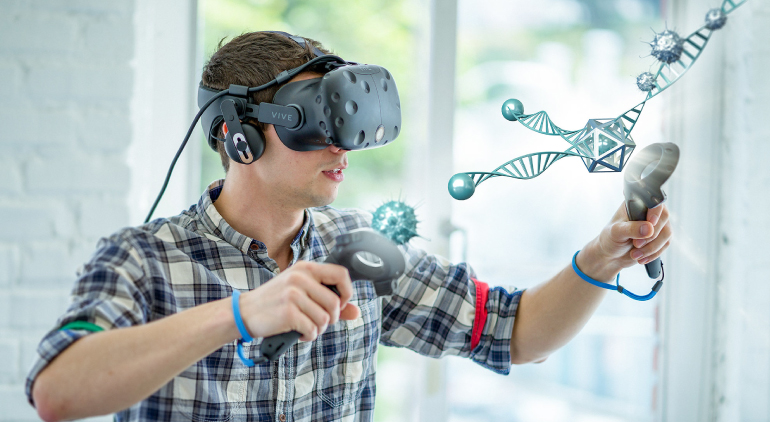The Power of Virtual Reality in Education Technology

Education technology is nothing but a method that is equipped to improve education systems and implement the most efficient methods of learning. Educational technology has, very apparently, transformed over the years.
We went from chalks and blackboards to markers and whiteboards; from textbooks to eBooks; from written instructions to 2D diagrams to 3D videos; and from heavy theoretical learning to balanced theoretical learning and practical implementation.
All of this has been possible only through the advancements in education technology.
In order to envision and comprehend the power of Virtual Reality in education technology, it is vital to question the necessity for these aforementioned advancements.
Has shifting from textbooks to eBooks and embracing VR technology in education really helped us learn more? Does the practical implementation of theories through virtual reality accelerate our learning in any way?
In summary, are we benefitting from advancements in education technology, including VR, to enhance our virtual reality learning experiences?
The answer to all these questions are a big fat “YES!”.
As humans, we are a part of such an elaborate society, developed over aeons because of the method of learning and teaching.
It was the necessity of teaching survival skills to all humans that brought the necessity of communication and allowed formation of social groups.
Almost everything we know is because it has been taught to us and we have learnt it! More importantly, and in response to all the questions above, as humans evolved, the methods of learning and teaching evolved.
We went from writing on stones and leaves to paper to typing on computers. All this because, as we discovered newer things and evolved, we updated our methods of learning and teaching accordingly.
Hence, advancements in educational technology is a necessity!
With generation alpha, we have seen how dependent all aspects of their lives are on technology. Generation alpha has not seen a world with no phones!
It is with this evident trajectory towards the digital age that advancements like VR trends in education technology will be pertinent.
2D diagrams are not enough for the rate at which students are learning today. To match their efficiency, VR is the most suited technology.
Virtual Reality in Education is Captivating and Efficient
We have known, perhaps even through first-hand experiences, that the best way of Virtual reality learning is by doing. However, traditional teaching methods do not cater to this particular philosophy.
While using multimodal forms of teaching works, it will not be as efficient as VR due to its lack of practicality.
Firstly, VR technology in education is an immersive tool that can transport you into a simulated version of wherever you please. Medical students can use VR to learn the workings of a kidney while actually being inside a simulation of a kidney!
They can even be in a simulation as a doctor conducting a simulated surgery for practical training. The environment can be designed to imitate an actual operation room with nurses assisting.
This type of training is engrossing and the resemblance to reality can motivate students to want to learn more.
Secondly, Virtual Reality in education enhances learning. Students may find it challenging to simply pay attention to hours of lectures with occasional videos.
In spite of teachers giving their best and keeping the class interesting, students still lose focus.
This is mostly because of complex concepts that are way too much information or abstract concepts. This is neither the fault of the teachers nor the students.
However, this shows why schools need VR education and how it could help teachers and students alike.
Using VR based applications can help teachers explain concepts explicitly and the detailed simulations helps students comprehend and still be engaged.
Related Posts : Innovative Education Through Virtual Machines
"Ready to explore a new way of learning? Try Virtual Reality and make your education journey even more exciting today! Discover new things, have fun, and learn like never before!"
Schools and Colleges Need VR Technology
Need is a strong word but, in this case, a compulsion. VR technology was first developed in the 1950s and 1960s. Hence, this popular computer technology has not recently been introduced to us.
However, understanding this technology has taken far longer than people thought. VR is so advanced that we are still trying to understand its true potential.
Yet, whatever we do know of the technology, has only helped us further our developments.
The entertainment sector has especially benefitted from VR technology and unravelled useful VR methods like gamification. This method, in spite of having the word “game” in it, can actually be used for school students.
Applications like VirtualSpeech and Ribbit-ing Discoveries helps improve skills through gamification.
While the first one can help high school students develop soft skills and prepare for interviews for colleges, the latter can help them with biology and learning how to dissect a frog.
The commonality in both is its method of motivation through gamification. The application scores performances based on which students can keep trying to improve their skill.
VR in higher education is more of a need due to the rigorous study schedules that students need to follow.
VR applications like 3D Organon and HoloAnatomy can aid practical learning for medical students while engineering students can use VR headsets to design and test prototypes and still be safe and sound in their dorm rooms.
Visit:- Turbofan Jet Engine
Furthermore, VR labs can provide students with research opportunities that are not bound by time or funding.
The power of VR in education technology is so strong that we can see the revolutionary path that learning has taken.
VR is not a technology that is as simple as 3D! The immersive technology in college is powerfully captivating, powerfully beneficial, and chiefly, powerfully educational, when used as above.
.png)
.png)



